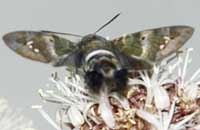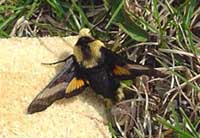Sphinginae subfamily
Sphingini tribe:
 |
This species has been enountered in nearby Kennebec County as a stray from
much further south. It might appear in the fall, but is unlikely.
The moth is a very strong flier and is
frequently encountered far north of its usual range.
|
 |
Ceratomia amyntor
WO,
the Elm Sphinx or Four-horned Sphinx
The upperside of the forewing is brown with dark brown and white
markings including a white costal area near the wing base, dark
streaks along the veins, and a white spot in the cell.
Larvae feed on Elm (Ulmus), birch (Betula), basswood (Tilia), and
cherry (Prunus). |
 |
The upperside of the forewing is pale brownish gray with wavy black
and white lines and a black-outlined white cell spot. The upperside
of the hindwing is gray with diffuse darker bands. |
 |
Dolba hyloeus
USGS, the Pawpaw Sphinx
The upperside of the forewing is dark brown with a dusting of white
scales. Some moths have patches of reddish or yellowish brown on the
wings. Larvae are not limited to pawpaw.
|
 |
The upperside of the forewing is gray with heavy black bands. The
upperside of the hindwing is brownish gray with no markings.
|
 |
This species is probably present.
The upperside of the forewing is gray-brown with wavy lines, black dashes, and one or
two small white spots near the center of the costa.
|
 |
This species is not recorded in Waldo, but, if you
grow tomatoes, you might encounter it.
|

|
Sphinx canadensis
WO,
Sphinx canadensis, the Canadian Sphinx, is not common, and is not
often reported anywhere,
but it is reported in Lincoln County.
Larval hosts are white ash (Fraxinus americana) and blueberry
(Vaccinium).
|
 |
Sphinx chersis
USGS, the Northern Ash Sphinx or Great Ash Sphinx
The upperside of the forewing is soft dark gray to blue-gray with
a series of black dashes, one of which reaches the wing tip.
|
 |
Sphinx drupiferarum
USGS, the Wild Cherry
Sphinx
Forewings, long and slender, are held close to the body when the
moth is at rest. We have them on P.E.I., but I do not see them nearly as frequently
as I see the other Sphingidae. |
 |
The lower forewings are predominantly brownish-yellow with a fairly
wide dark bar along the inner margin. At rest the wings hug the body,
giving the moth a long slender look.
|
 |
Sphinx luscitiosa
WO,
the Canadian Sphinx or
Clemen's Sphinx
The upperside of the forewing is yellowish gray in males and pale
gray with a faint yellow tint in females. It seems to be an uncommon
species. |
 |
If you have blueberries in the woods, then you probably have the
Poecila Sphinx.
They are pretty common here on Prince Edward Island, but don't fly
too far south of Massachusetts, being replaced by Sphinx gordius
in Connecticut. |
Smerinthini Tribe:
 |
The adults are also highly variable; sometimes wings of an individual
may be all one color or may have several colors, ranging from pale to
dark brown, and may have a white or pink tinge.
See the file for the female; she is different. |
 |
Pachysphinx modesta
USGS, the Modest Sphinx or Poplar Sphinx
This moth has a large, heavy body, and females can be remarkably plump.
They are common on Prince Edward Island. |
 |
It is recorded for northeastern Massachusetts and western Connecticut,
and makes its way into southern Maine.
It would be more common
in more southerly locales.
|
 |
Named for the dull grey-blue spot in the hindwing, this moth has a
wide distribution and is probably common in Piscataquis County.
I regularly see them on Prince Edward Island, and they are reported as far south as Florida. |
 |
Paonias myops
USGS, the Small-eyed Sphinx
Named for the small eye-spot in the hindwing, this moth has a wide
distribution and is probably present in Piscataquis, although not
confirmed.
I regularly see them on Prince Edward Island, and they are reported
as far south as Florida.
|
 |
This species probably flies throughout Maine.
At my home in Montague, P.E.I., Canada, they are quite common.
The light-coloured, forewing, apical arc does not reach the outer margin in its lower half. |
 |
This moth is widely distributed and fairly common. I suspect the same in
Lincoln County.
Near the right forewing apex there is a complete light coloured arc (letter "c") reaching the outer margin. |
Macroglossinae subfamily
Dilophonotini tribe:
 |
Aellopos tantalus
USGS, the Tantalus Sphinx.
Body reddish brown with wide white band across abdomen.
Fw upperside reddish brown with black cell spot, 3
white spots near gray marginal area. Pale streak runs from
cell spot to inner margin. USGS lists A. titan;
rare encounter was more likely with wind assisted migrant stray of A. tantalus.
|
See Hemaris comparison to help distinguish
the next three species.
 |
Hemaris thysbe, USGS, the Hummingbird Clearwing
It is not difficult to see why many gardeners would mistake an
Hemaris thysbe moth for a small hummingbird as it hovers,
sipping nectar from flowers through a long feeding tube.
|
 |
Hemaris diffinis
USGS, the
Snowberry Clearwing or Bumblebee Moth
Adults mimic bumblebees and are quite variable. The wings are basically clear, with dark brown to
brownish-orange veins, bases and edges. The thorax is golden-brown to
dark greenish-brown. The abdomen tends to be dark (black) with 1-2
yellow segments before the tip.
|
 |
Hemaris gracilis
USGS, the
Slender Clearwing or Graceful Clearwing
Hemaris gracilis is distinguished from similar species by a pair of
red-brown bands on the undersides of the thorax, which varies from
green to yellow-green dorsally and sometimes brown with white
underneath.
|
Philampelini tribe:
 |
This moth is not officially reported for Hancock,
but it is fairly often reported
along the coast from southern New Jersey
to central Maine.
Note the differences between this moth and the Pandorus Sphinx.
|
 |
If you have Grape or Virginia Creeper nearby, then you probably have
this species.
I often get asked to identify larvae from areas where they have not
previously been reported.
|
Macroglossini tribe:
 |
Amphion floridensis
USGS.
The Nessus sphinx flies during the day and at dusk: two bright yellow bands on tufted abdomin. At rest,
dark red-brown upperwings hide hw red-orange median band and yellow spot. In some specimens the median band
may be very pale or almost absent.
Concave regions of fw outer margin also have pale yellow markings in fringe area.
|
 |
They are common in New Jersey and common
here on Prince Edward Island.
The lower wings of this hawkmoth are a solid brownish-orange, matching the body colour.
You will often see this species listed as Darapsa pholus,
especially in older literature.
|
 |
Darapsa myron
WO, the Virginia Creeper Sphinx or the
Grapevine Sphinx
FW upperside is dark brown to pale yellowish gray, with an olive tint
(often quite green).
On the costal margin there is a dark rectangular patch, although this
may be reduced or absent. HW upperside is pale orange.
|
 |
If you have hydrangea growing near a stream, then you may have the
Hydrangea Sphinx. It has not been widely reported, however, and
probably is uncommon.
|
 |
The moth's outer margin of the forewing is deeply scalloped.
The upperside is light brown with dark brown markings.
There is a small black and white spot near the tip.
The upperside of the hindwing is orange-brown with a dark brown outer
margin and median line.
|
 |
Hyles gallii USGS, the Bedstraw Hawk Moth
or Gallium Sphinx confirmed in Hancock County.
Some years I see them on P.E.I., some years, I do not.
|
 |
Hyles lineata unlikely stray, the White-lined Sphinx
This species is reported from Hancock County, probably as a migrant stray from further south.
non resident stray |
 |
Proserpinus flavofasciata
WO, the Yellow-banded Day Sphinx.
The fw upperside is medium to dark brown with a faint to distinct white median band. The hw upperside is dark brown
with a wide orange median band which may not reach the inner margin. Moth mimics a bumblebee.
Adults fly in afternoon as a single brood from April-June in meadows in coniferous
forests.
|
 |
Adults are said to mimic bumblebees and make a buzzing sound when
feeding. The wing margins are scalloped. The upperside of the
forewing is dark brown with light brown bands and markings. The
upperside of the hindwing is yellow with a wide black outer margin.
|
|
|
